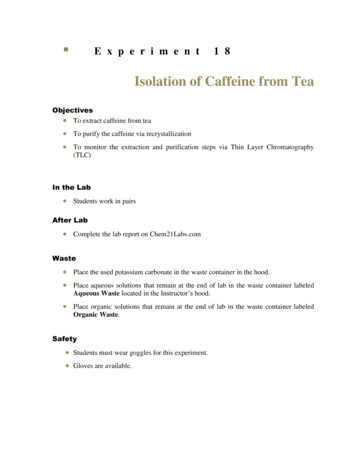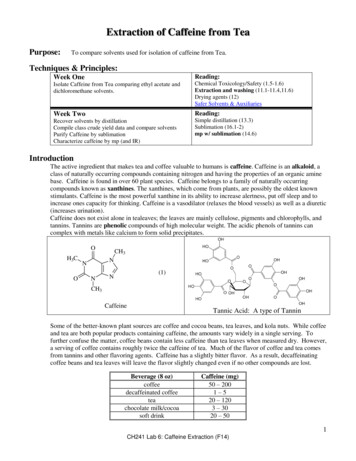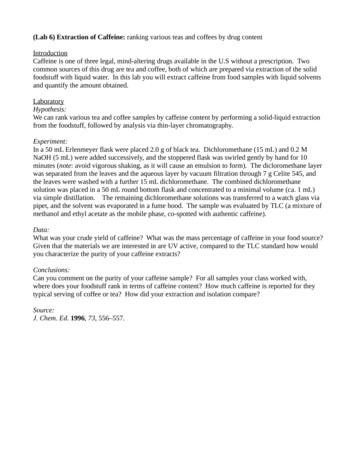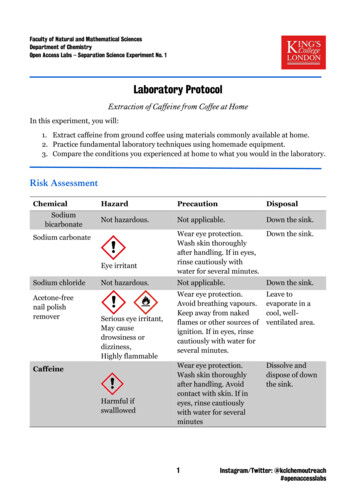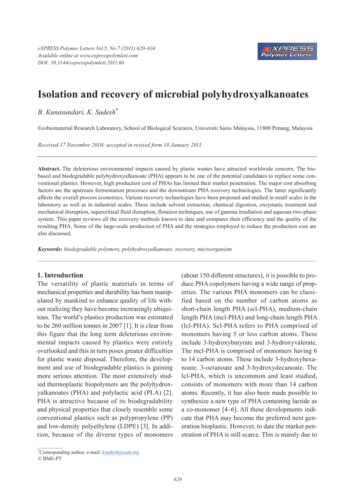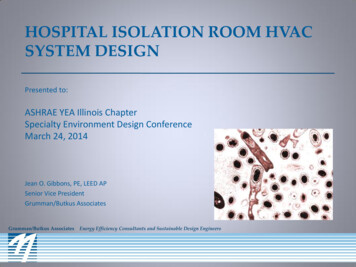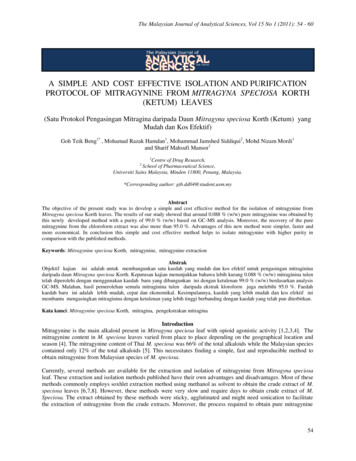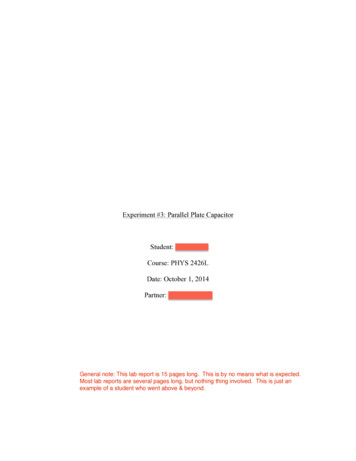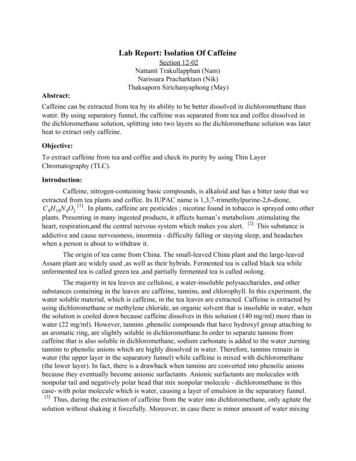
Transcription
Lab Report: Isolation Of Caffeine ection 12 02SNattanit Trakullapphan (Nam)Narissara Pracharktam (Nik)Thaksaporn Sirichanyaphong (May)Abstract:Caffeine can be extracted from tea by its ability to be better dissolved in dichloromethane thanwater. By using separatory funnel, the caffeine was separated from tea and coffee dissolved inthe dichloromethane solution, splitting into two layers so the dichloromethane solution was laterheat to extract only caffeine.Objective:To extract caffeine from tea and coffee and check its purity by using Thin LayerChromatography (TLC).Introduction:Caffeine, nitrogen containing basic compounds, is alkaloid and has a bitter taste that weextracted from tea plants and coffee. Its IUPAC name is 1,3,7 trimethylpurine 2,6 dione,C 8H 10N 4O2 [1] . In plants, caffeine are pesticides ; nicotine found in tobacco is sprayed onto otherplants. Presenting in many ingested products, it affects human’s metabolism ,stimulating theheart, respiration,and the central nervous system which makes you alert. [2] This substance isaddictive and cause nervousness, insomnia difficulty falling or staying sleep, and headacheswhen a person is about to withdraw it.The origin of tea came from China. The small leaved China plant and the large leavedAssam plant are widely used ,as well as their hybrids. Fermented tea is called black tea whileunfermented tea is called green tea ,and partially fermented tea is called oolong.The majority in tea leaves are cellulose, a water insoluble polysaccharides, and othersubstances containing in the leaves are caffeine, tannins, and chlorophyll. In this experiment, thewater soluble material, which is caffeine, in the tea leaves are extracted. Caffeine is extracted byusing dichloromethane or methylene chloride, an organic solvent that is insoluble in water, whenthe solution is cooled down because caffeine dissolves in this solution (140 mg/ml) more than inwater (22 mg/ml). However, tannins ,phenolic compounds that have hydroxyl group attaching toan aromatic ring, are slightly soluble in dichloromethane.In order to separate tannins fromcaffeine that is also soluble in dichloromethane, sodium carbonate is added to the water ,turningtannins to phenolic anions which are highly dissolved in water. Therefore, tannins remain inwater (the upper layer in the separatory funnel) while caffeine is mixed with dichloromethane(the lower layer). In fact, there is a drawback when tannins are converted into phenolic anionsbecause they eventually become anionic surfactants. Anionic surfactants are molecules withnonpolar tail and negatively polar head that mix nonpolar molecule dichloromethane in thiscase with polar molecule which is water, causing a layer of emulsion in the separatory funnel.[3]Thus, during the extraction of caffeine from the water into dichloromethane, only agitate thesolution without shaking it forcefully. Moreover, in case there is minor amount of water mixing
in the dichloromethane , anhydrous sodium sulfate is added to the Erlenmeyer flask containingextracted caffeine to absorb the leaked water ,and it helps breaking emulsion forming in the flaskas well.Materials:1.2.3.4.5.6.7.8.Coffee and Tea solution30 milliliters of dichloromethane6 teaspoons of Sodium sulfate15 mL Erlenmeyer flaskSeparatory funnelGraduated cylinderRotary evaporatorMelting point apparatusProcedure:Caffeine Extraction1.2.3.4.Set a separatory funnelPut 15 mL of coffee and tea solution in a separatory funnelPut 15 mL of dichloromethane in the separatory funnel with coffee and tea solution.Stopper the separatory funnel. Hold the stopper into the neck of the funnel tightly andgently shake it. Then, turn the stopcock away from body and open the stopcock to releasepressure. Gently shake it and release pressure for several times until the solution anddichloromethane mix together. Close the stopcock.5. Put the funnel back to the stand and allow the mixture to settle until it separates into twolayers.6. Drain the lower layer, mixed dichloromethane layer into a Erlenmeyer flask carefully. Donot drain any drop of the upper layer in the flask.7. Repeat step 4 to 6 one more time.8. Add 6 spatulas of sodium sulfate into the flask with mixed dichloromethane and swirl it.9. Filtrate mixed dichloromethane into a micro filter flask using Hirsh with filter paper.10. Transfer mixed dichloromethane to a pot of a rotary evaporator. Turn on the instrumentto separate dichloromethane and caffeine.Thin layer Chromatography1. As the picture on the right, on the chromatographyplate, using pencil, draw 2 lines for starting andfinishing line. Draw two spot on the starting line forsample and references. (Be careful not to touch theplate surface!!)2. Put sample and reference of pure caffeine on the spotdrown.
3. Put the TLC plate into a solvent, ethyl acetate.4. Let it the solution runs until reaching the finishing line. Take if off and let it dry.5. Stain or expose the TLC plate to iodine vapor.Measuring Melting point1. Load dried caffeine reference powder into a capillary tube and tap the capillary tube on ahard surface until the sample packs into the bottom.2. Place the capillary tube into the melting point apparatus and turn the heating stage on.3. Carefully observe the sample through the eyepiece and note down the temperature whenthe sample starts to melt.Results:Figure 1: The result of Thin Layer Chromatography comparing the sample and the reference ofextracted caffeine shows that the sample and the reference were carried up to the same position.Therefore, their abilities of being absorbed were the same, showing that the caffeine is pure.
Figure 2: After heating the sample at around its melting point (235 degree celsius), the samplewas burnt before melting.DiscussionExtracting caffeine with the use of dichloromethane from the coffee and tea leaves ,whichconsist not only caffeine but also tannins which is slightly soluble in dichloromethane, sodiumbicarbonate is added to react with tannins and turn it to its salt or phenolic anions. This formenables tannins to totally dissolve in water instead of dichloromethane. Because caffeine withdichloromethane and tannins with water do not form homogenous mixture, due to theirdifferences in polarity and density, two layers present in the separatory funnel.The tanninssolution remains above the dichloromethane solution, so by turning the stopcock we will get thedichloromethane solution easier.As a result of emulsion forming between the two layer,anhydrous sodium sulfate was added to absorb possibly leaked water and to break the emulsioncaused by turning tannins to surfactants.After that, the caffeine was separated from thedichloromethane by using rotary evaporator. Dichloromethane would be evaporated first since itsboiling point is in the range of 30 and 40 degree celsius while caffeine’s boiling point is 173degree celsius a lot higher than that of dichloromethane so the caffeine solution remained in thecontainer.In this experiment, we extracted substances in coffee and tea solution to test whether ifthere was caffeine in it. From the results, it was indicated that it was caffeine since the similarityof result from thin layer chromatography could be seen; however, there were unexpected errorsin the experiment. The errors could be separated into two stages: errors of TLC stage and ofmelting point measurement. First, to test using TLC, the caffeine sample was overloaded on theplate, seen as a smear. Also, because the plate was taken out too long, the color from iodinestaining began to disappear because the sample was invisible under UV light. Therefore, it mightnot be seen so clearly. Moreover, we could not do the calculation of TLC because we had usediodine to stain the result, in which iodine was radioactive so it was dangerous. Second, inmeasuring its melting point, we were to compare melting point of the caffeine reference and the
sample extracted, but we could not. The sample was not dry enough to check for its meltingpoint since we needed it in powder form to be loaded to the bottom of a capillary tube. When itwas still wet, it got stuck and was not able to go to the bottom. Therefore, we could not check themelting point of the sample to compare to the one of the reference.However, the errors presented in this experiment were good lessons for us to improve tofurther experiments in the future. We learned from this experiment that we should drop lesssample on TLC in order to get a good result and minimize errors. Moreover, other experimentswe can do in the future based on the results from this experiment is to determine whether theextracted caffeine is pure or not. Also, we may conduct the experiment further by testing thepurity of extracted caffeine from different brands of coffee bag selling in market.CalculationsIn this experiment we used iodine to help us see the result on TLC, however the iodinewas a harmful chemical so actually we couldn’t measure the real distance traveled by the solventand the distance traveled by the compound. Therefore, we assumed the approximate values inorder to show an example of how to calculate the retention factor from TLC. According to theresult of Thin Layer Chromatography, the distance traveled by the compound of the sample isaround 2 cm while the distance traveled by the solvent front is 5 cm so from the retention factorformula; we divide the distance traveled by the compound by the distance traveled by the solventfront which is equal to 0.4 cm. For the reference, we also got the same number of distancetraveled by the compound which is around 2 so the retention factor of the reference is also equalto 0.4 cm.
ConclusionBased on the result, substance that was extracted from coffee and tea solution was caffeine dueto its ability of being absorbed using TLC, which was similar to the m.nih.gov/compound/caffeine#section Tophttp://www.webmd.com/sleep disorders/guide/insomnia symptoms and causeshttp://www.rsc.org/learn chemistry/resources/chemistry in your cupboard/finish/6The laboratory instruction: Experiment #6 Isolation Of Caffeine From Tea Leaves
Caffeine, nitrogen containing basic compounds, is alkaloid and has a bitter taste that we extracted from tea plants and coffee. Its IUPAC name is 1,3,7 trimethylpurine 2,6 dione, C8H10N4O2 . In plants, caffeine are pesticides ; nicotine found in tobacco is sprayed onto other [1] plants. Presenting in many ingested products, it affects human’s metabolism ,stimulating theFile Size: 310KBPage Count: 6
